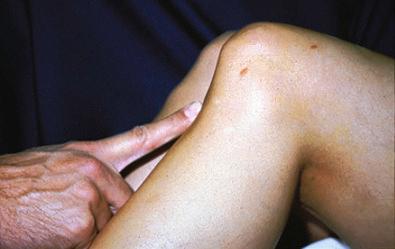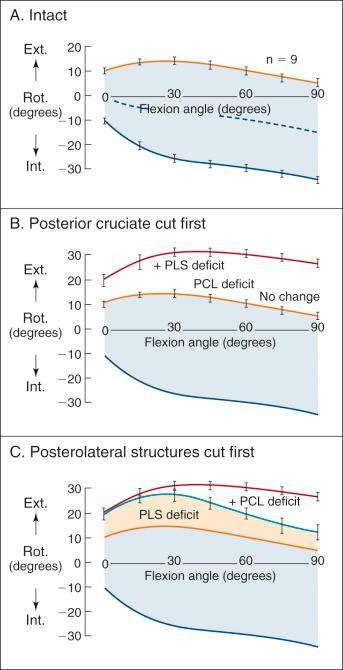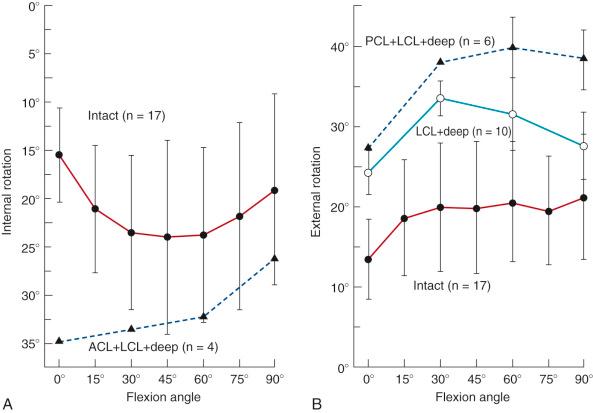Physical Address
304 North Cardinal St.
Dorchester Center, MA 02124
This chapter provides a summary of the important biomechanic principles gained from our publications and other investigations regarding the posterior cruciate ligament (PCL) and posterolateral structures (PLSs). The primary PLSs of the knee joint are the fibular collateral ligament (FCL) and popliteus muscle-tendon-ligament unit (PMTL), including the popliteofibular ligament (PFL) and posterolateral capsule (PLC). Additional PLSs that may be injured and require repair are iliotibial band femoral and tibial attachments, meniscal tibial and femoral attachments (including fascicles), the fabellofibular ligament, and the lateral capsule, including the anterolateral ligament. All of these structures are illustrated in Chapter 2 . Data from these investigations provide the basis for the diagnosis of abnormal knee motion limits in single and combined ligament injuries and allow the surgeon to plan the appropriate ligament repair and reconstructive procedures.
Limits of AP translation, internal-external tibial rotation, varus-valgus rotation under specific forces and moments were measured in cadaveric studies.
100-N force applied to determine the AP limits, 5 N-m for internal-external rotation limits, 20 N-m for adduction-abduction (varus-valgus) limits from 0 degrees to 100 degrees of knee flexion.
No primary restraint to hyperextension, structures work together: entire posterior knee capsule, oblique popliteal ligament, fabellofibular ligament, PCL, and ACL.
PCL primary restraint to posterior tibial translation throughout knee flexion.
Increased posterior translation at 30 to 45 degrees flexion associated with injury to PLS, medial ligament structures.
No increase in external tibial rotation PCL cut alone.
PLS primary restraint external tibial rotation low knee flexion positions; test 20-40 degrees of flexion.
Increases in external tibial rotation at 90 degrees indicate injury to PLS and PCL
PLS primary restraint adduction (varus) rotation limits.
Loss PLS converts both cruciate ligaments into primary restraints for varus loading.
Combined rupture PCL/PLS requires surgical restoration of all structures.
Abnormal medial or lateral joint opening (gap test) at arthroscopy: concurrent medial or lateral ligament reconstruction.
A series of studies were conducted in cadaveric knees to measure the limits of anteroposterior (AP) translation, internal-external tibial rotation, and varus-valgus rotation (using a six-degrees-of-freedom electrogoniometer) under specific forces and moments with a verified testing apparatus previously described.
The PCL and PLSs were sectioned in 15 knees, first separately and then in combination, to measure the resultant abnormal knee motion limits to simulate isolated and combined ligament ruptures. The PLSs in this investigation included the FCL, PMTL, and PLC. A 100-N force was applied to determine the AP limits; 5 N-m was used for internal-external rotation limits; and 20 N-m was used for adduction-abduction (varus-valgus) limits from 0 to 100 degrees of knee flexion.
In these ligament-cutting experiments, the popliteus tendon was sectioned from the femoral attachment, which effectively removed the entire popliteus muscle tendon and PFL static function. In other experiments to be described, the PFL was sectioned independently of the popliteus tendon attachment to investigate the individual function of this ligament. The PLC was removed, including all soft tissue structures posterior to the FCL, to ensure that the individual soft tissue components were removed. This included, in addition to the PLC, other tissue components compromising the fabellofibular ligament and capsular arm of the biceps femoris short head.
The normal fully hyperextended knee position averaged 5.6 ± 3.8 degrees. After sectioning the PCL or PLS alone, only slight and clinically insignificant increases in hyperextension were noted (such as 2.6 ± 0.09 degrees when the PLS was cut). When both the PCL and PLS were sectioned, the increase in hyperextension was 4.0 ± 1.4 degrees.
The data indicate that there is no primary restraint in the knee that resists hyperextension. Many structures work in synergy to resist hyperextension, and it is therefore not surprising that sectioning the PLS or PCL results in only a small increase. Other structures anatomically positioned to resist hyperextension include the entire posterior knee capsule (femoral-meniscal tibial attachments), oblique popliteal ligament, fabellofibular ligament, and posterior fibers of the PCL and anterior cruciate ligament (ACL). A reconstructive procedure is described in Chapter 17 for knees with severe knee hyperextension. This procedure is performed in addition to other required ligament reconstructive procedures.
The normal anterior and posterior translation knee limits are shown in Figure 15-1, A . The increase in these limits when the PCL is cut are shown in Figure 15-1, B , and the further increase in these limits when the PLSs are also sectioned is shown in Figure 15-1, C . The values for the increase in motion limits are given in Table 15-1 .
![FIG 15-1, Limits of anterior (ant.) and posterior (post.) translation (vertical axis) when a 100-N anteroposterior (AP) force is applied. A, Intact knees. The curves show the average limits of motion and the standard deviation for nine knees. The range of total AP translation of the intact knee is shaded green. B, The posterior cruciate ligament (PCL) is cut first. The increase in posterior translation after cutting the PCL is shown in the area shaded in orange (PCL deficit). The limit of posterior translation, and therefore the amount of increase, is controlled by the remaining intact structures. The unshaded portion (+ posterolateral structure [PLS] deficit) shows the added increase when the PLSs (fibular collateral ligament, capsule, popliteus muscle-tendon-ligament) were cut after the PCL had first been removed. A concurrent external rotation took place with this cut. C, The PLSs are cut first. There was only a small increase (PLS deficit) in the posterior limit near full extension when the posterolateral structural elements were cut first. A concurrent external rotation was also present. FIG 15-1, Limits of anterior (ant.) and posterior (post.) translation (vertical axis) when a 100-N anteroposterior (AP) force is applied. A, Intact knees. The curves show the average limits of motion and the standard deviation for nine knees. The range of total AP translation of the intact knee is shaded green. B, The posterior cruciate ligament (PCL) is cut first. The increase in posterior translation after cutting the PCL is shown in the area shaded in orange (PCL deficit). The limit of posterior translation, and therefore the amount of increase, is controlled by the remaining intact structures. The unshaded portion (+ posterolateral structure [PLS] deficit) shows the added increase when the PLSs (fibular collateral ligament, capsule, popliteus muscle-tendon-ligament) were cut after the PCL had first been removed. A concurrent external rotation took place with this cut. C, The PLSs are cut first. There was only a small increase (PLS deficit) in the posterior limit near full extension when the posterolateral structural elements were cut first. A concurrent external rotation was also present.](https://storage.googleapis.com/dl.dentistrykey.com/clinical/FunctionofthePosteriorCruciateLigamentandPosterolateralLigamentStructures/0_3s20B9780323329033000159.jpg)
| ANGLE OF FLEXION (DEGREES) | |||||
|---|---|---|---|---|---|
| 0 | 15 | 30 | 60 | 90 | |
| Anterior Limit (mm) | |||||
| All cut | 0.5 ± 0.8 | 0.6 ± 0.6 | 0.7 ± 0.7 | 0.4 ± 1.3 | 0.8 ± 1.0 |
| Posterior Limit (mm) | |||||
| PCL cut | 1.0 ± 1.6 | 3.6 ± 1.6 | 6.4 ± 1.5 | 9.6 ± 1.3 | 11.4 ± 1.9 |
| PLS cut | 3.1 ± 0.7 | 1.9 ± 0.8 | 1.4 ± 1.1 | 0.7 ± 0.8 | 0.5 ± 0.7 |
| All cut | 6.6 ± 2.7 | 11.3 ± 3.1 | 15.8 ± 3.0 | 20.7 ± 3.4 | 21.5 ± 3.4 |
| External Rotation Limit (Degrees) | |||||
| PCL cut | 0.4 ± 0.5 | 0.2 ± 0.5 | 0.2 ± 0.6 | 0.4 ± 0.9 | 0.6 ± 1.2 |
| PLS cut | 8.5 ± 2.6 | 11.8 ± 3.0 | 13.0 ± 2.3 | 5.2 ± 9.0 | 5.3 ± 2.6 |
| All cut 1 | 10.5 ± 4.0 | 14.2 ± 3.7 | 18.0 ± 3.8 | 21.0 ± 3.1 | 20.9 ± 2.8 |
| Varus Angulation Limit (Degrees) | |||||
| FCL cut | 2.5 ± 0.4 | 4.5 ± 0.4 | 5.7 ± 0.2 | 5.5 ± 0.6 | 4.3 ± 0.9 |
| PCL cut | 0.4 ± 0.6 | 0.4 ± 0.6 | 0.4 ± 0.6 | 0.8 ± 0.6 | 1.4 ± 0.6 |
| PLS cut | 6.4 ± 2.3 | 7.9 ± 2.0 | 9.0 ± 2.0 | 8.3 ± 3.7 | 6.8 ± 4.5 |
| All cut | 8.1 ± 2.5 | 11.3 ± 3.0 | 14.2 ± 3.3 | 18.9 ± 3.4 | 21.2 ± 3.0 |
| Valgus Angulation Limit (Degrees) | |||||
| PCL cut | 0.3 ± 0.6 | 0.3 ± 1.0 | 0.5 ± 1.7 | 0.7 ± 1.9 | 0.5 ± 1.0 |
The data show that the PCL is a primary restraint to posterior tibial translation throughout knee flexion, with the exception of a small increase in posterior translation at full extension when the PLSs are cut. The clinical finding of a knee with increased posterior translation at 30 to 45 degrees of knee flexion, similar to the posterior translation limit at 90 degrees ( Fig. 15-2 ), indicates associated injury to the PLSs and the medial structures.

It should be noted that a complete description of the translation limits requires an anatomic measurable point on the tibia, which is selected at the central coronal point on the tibia. The limits of posterior translation to the medial and lateral tibiofemoral joints are described in a subsequent study.
In a knee with a combined deficiency of the PCL and PLS, the abnormal posterior tibial translation is at least four to five times the normal limit throughout knee flexion.
The normal knee motion limits to internal and external tibial rotation are shown in Figure 15-3, A . There is no increase in external tibial rotation when the PCL is cut alone (see Fig. 15-3, B ). This finding demonstrates that the PLSs are the primary restraint for external tibial rotation throughout knee flexion. When only the PLSs are sectioned, an increase in external tibial rotation occurs (see Fig. 15-3, C ), which is greatest at 30 degrees of knee flexion. The amount of external tibial rotation decreases as the knee is flexed, showing the influence of the PCL in limiting external tibial rotation after the PLSs are sectioned.

These data indicate that the PLSs provide the primary restraint to external tibial rotation at low knee flexion positions and therefore should be tested in this range (20-40 degrees of flexion). Increases in external tibial rotation at 90 degrees indicate injury to both the PLS and PCL, consistent with the dial test (see Chapter 17 ). The data are in disagreement with the classic interpretation of the posterolateral drawer test at 90-degree flexion, indicating injury to only the PLS. The resisting function of the FCL, popliteus tendon, and PFL is described in separate studies mentioned later in this chapter.
Gollehon and coauthors reported similar results showing an increase in external tibial rotation of 20-degree flexion after sectioning the PLS at 30 degrees of flexion. Sectioning of the PCL along with the PLS did not produce further significant increases in external tibial rotation ( Fig. 15-4 ).

Become a Clinical Tree membership for Full access and enjoy Unlimited articles
If you are a member. Log in here